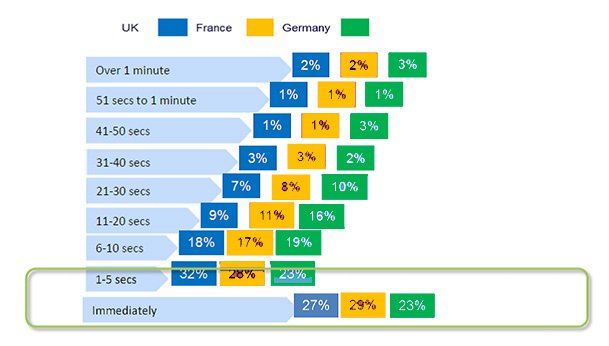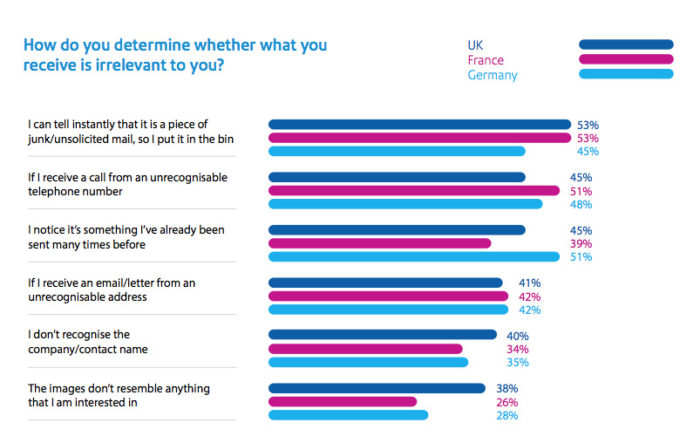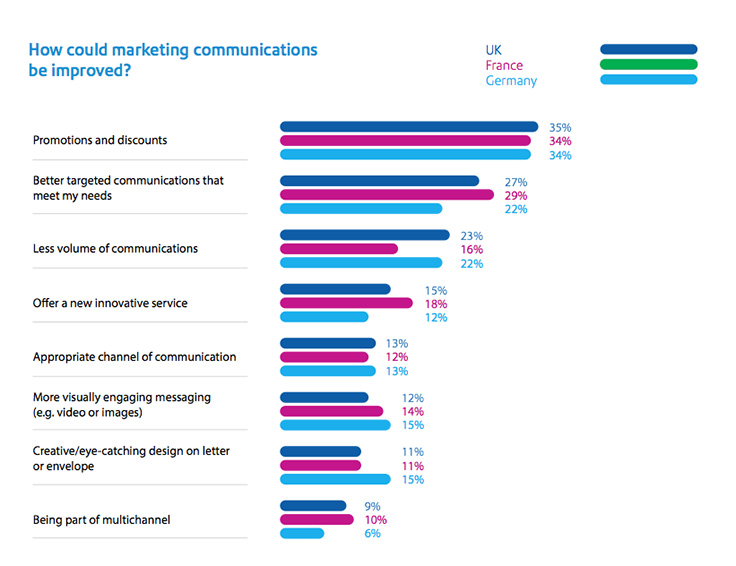Every 5 seconds, the sound of thunder travels one mile. Every 5 seconds, the average person blinks. Every 5 seconds, 17 million emails are sent and 205,000 Facebook posts are posted. It‘s a busy planet – so how do marketers cut-through to make an impact? Find out here . . .
In five seconds, around 500 lightning strikes will have hit the ground. The universe will have expanded around 46 miles (according to figures from Buzzfeed). And consumers will have deleted or thrown away another marketing communication.
Businesses have just five seconds to get their message across to their audiences, according to European research from global technology firm Pitney Bowes. The data, gleaned from conversations with 3,256 consumers and 234 businesses across the UK, France and Germany, reveals the extent of the challenge facing marketers jostling to create cut-through in a noisy environment.
59% of Britons in the study discard irrelevant marketing communications within just five seconds of viewing it. Consumers in France and Germany are slightly more tolerant, at 47% and 46% respectively, but the research confirms what marketers have been concerned about for several years: that the industry is at a tipping point when it comes to customer engagement.
Taking the five second rule to a new level – via data and technology
In what Pitney Bowes is calling ‘The New Five Second Rule’, the marketing industry must use the data and technology available to craft personalised, relevant, creative and meaningful communications that create lasting impact.

The research identified that each week consumers receive an average of 17 marketing emails, plus 12 messages across social media; 10 promotion text messages; 10 phone calls; and nine printed promotions – an average of more than eight a day. These communications are just a small part of the hundreds of advertising messages consumers are exposed to every day: research carried out by Media Dynamics numbers this at around 360 per day across physical and digital channels.
The communications gap

Pitney Bowes’ study found that 60% of Brits, 53% of Germans and 51% of French consumers really dislike marketing phone calls, yet 71% of businesses are still using the phone to make contact.
Despite having more than 40 marketing channels to choose from to drive customer engagement, according to research from Smart Insights, many businesses are sticking to ‘traditional’ media channels to communicate with their audiences, which isn’t going down too well: Pitney Bowes’ research reveals that 71% of businesses in the UK, France and Germany rely on phone calls as part of their marketing mix. If these businesses had stopped to ask consumers how they felt about this, they would find that 60% of UK consumers, 53% of German consumers and 51% of French consumers actually find marketing phone calls extremely irritating, according to the Pitney Bowes study.
Whether the reason businesses rely on phone calls is down to their reticence to invest in digital transformation programmes, or whether it is more of a ‘This is how we’ve always done it, why change?’ attitude remains to be seen.
Either way, there is a significant gap between the communications that consumers want to receive and the communications businesses are sending. Marketers must address this, or risk alienating customers and losing business.
Opt-in and opt-out
Another reason for marketers to bridge this communications gap between what consumers receive and what they want is the major new European legislation coming into play next year. In May 2018, the EU GDPR will become effective, with far-reaching consequences for the marketing industry, particularly when it comes to consumer consent. Email and SMS marketing will need opt-in consent, while telephone and direct mail will require an opt-out. If your customers don’t like your communications, they can quickly and easily make this very clear. Never has there been a more important time to listen to consumers.

Data – a marketer’s obsession
Yahoo!’s founder Jerry Yang advised us to: “Above all, get obsessed about data”. As marketers, it should be a given that we are infatuated with data – with its capture, its accuracy, its cleanliness, its security: in fact, everything about it. When you have customers who are dissatisfied with the communications they receive, who are feeling disengaged and generally a bit ‘meh’ about your marketing messages – or choose to bin or delete them within just five seconds – it’s time to look to your data to unlock the answer. Here’s why:
- Consumers want to share their data, if it results in personalised communications
The majority of businesses are still largely collecting name, address, email and phone numbers. Pitney Bowes’ study reveals that consumers are perfectly willing to share more information if it means they receive more personalised, relevant, accurate communications: sharing information on hobbies and interests, for example, with 55% of consumers questioned in the UK, 53% in Germany and 52% in France happy to provide this data. Consumers are also willing to share information on buying habits, with 44% of respondents in France, 40% in the UK and 35% of respondents in Germany happy to do so. Putting the people, processes, technologies and systems in place to be able to increase the variety of data collected will drive results.
- Data-driven insights increase response rates
Over a quarter of consumers said that better targeted communications that met their needs would make them more likely to respond. Using customer data more effectively would enable these accurate, precise communications. 62% of businesses in the Pitney Bowes survey feel they are not using their customer data to the full, so this presents a major opportunity for businesses to refresh their data strategies and deliver tightly targeted communications.

- Data is the driving force behind exciting new customer engagement channels
Channels such as interactive personalised video are now becoming integrated into businesses’ customer engagement strategies. Built on real-time data, it draws together intelligence gathered across different channels, resulting in a creative, engaging communications tool. The research cited earlier found that nearly half the German consumers (44%) surveyed, 42% of UK consumers and over a third (38%) of French consumers would be likely to engage if the physical or digital communication they received was more clever and creative.
- Data reveals connections and provides context
Gaining a deeper understanding into customer data enables businesses to make strategic forecasting decisions. It facilitates behavioural analysis, trend predictions and unearths connections. It also enables tailored messaging of offers and deals: 34% of respondents in the survey say that including promotions and offers would improve their response to marketing communications.
- Data improves business performance
In the Pitney Bowes research cited earlier, 86% of businesses questioned in the UK, France and Germany are seeing business improvements as a direct result of the data they’re collecting. They’re using it to track customer behaviour; to increase their knowledge on customer preferences; to fuel product and service innovation; to drive segmentation strategies; and to understand their customers’ lifetime value to the company.
So how can awareness of the ‘New Five Second Rule’ help marketers who are struggling to create impact and grab that valuable but all-too-brief attention? They need to ensure they deliver refined, personalised, innovative campaigns that are built on data-driven insight, across physical and digital channels. Then customers are more likely to sit up and take notice of brands and the results will be reflected in business performance.
Read also:
Six steps brands need to take to better engage via their email marketing campaign
Using personalisation and contextual marketing to transform email marketing campaigns









Leave your thoughts